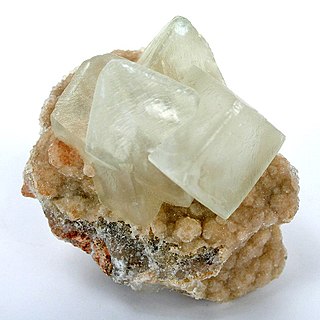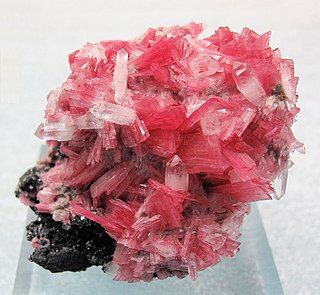
Turquoise is an opaque, blue-to-green mineral that is a hydrous phosphate of copper and aluminium, with the chemical formula CuAl6(PO4)4(OH)8·4H2O. It is rare and valuable in finer grades and has been prized as a gemstone for millennia due to its unique hue.

Chalcopyrite ( KAL-kə-PY-ryte, -koh-) is a copper iron sulfide mineral and the most abundant copper ore mineral. It has the chemical formula CuFeS2 and crystallizes in the tetragonal system. It has a brassy to golden yellow color and a hardness of 3.5 to 4 on the Mohs scale. Its streak is diagnostic as green-tinged black.

Greenockite is a rare cadmium bearing metal sulfide mineral consisting of cadmium sulfide (CdS) in crystalline form. Greenockite crystallizes in the hexagonal system. It occurs as massive encrustations and as hemimorphic six-sided pyramidal crystals which vary in color from a honey yellow through shades of red to brown. The Mohs hardness is 3 to 3.5 and the specific gravity is 4.8 to 4.9.

Smithsonite, also known as zinc spar, is the mineral form of zinc carbonate (ZnCO3). Historically, smithsonite was identified with hemimorphite before it was realized that they were two different minerals. The two minerals are very similar in appearance and the term calamine has been used for both, leading to some confusion. The distinct mineral smithsonite was named in 1832 by François Sulpice Beudant in honor of English chemist and mineralogist James Smithson (c.1765–1829), who first identified the mineral in 1802.

Aurichalcite is a carbonate mineral, usually found as a secondary mineral in copper and zinc deposits. Its chemical formula is (Zn,Cu)5(CO3)2(OH)6. The zinc to copper ratio is about 5:4. Copper (Cu2+) gives aurichalcite its green-blue colors.

Chrysocolla ( KRIS-ə-KOL-ə) is a hydrous copper phyllosilicate mineral and mineraloid with the formula Cu
2 – xAl
x(H
2Si
2O
5)(OH)
4⋅nH
2O (x < 1) or (Cu, Al)
2H
2Si
2O
5(OH)
4⋅nH
2O).

Rhodonite is a manganese inosilicate, with the formula (Mn, Fe, Mg, Ca)SiO3, and member of the pyroxenoid group of minerals, crystallizing in the triclinic system. It commonly occurs as cleavable to compact masses with a rose-red color (its name comes from Ancient Greek ῥόδον (rhódon) 'rose'), often tending to brown due to surface oxidation. The rose-red hue is caused by the manganese cation (Mn2+).

Adamite is a zinc arsenate hydroxide mineral, Zn2AsO4OH. It is a mineral that typically occurs in the oxidized or weathered zone above zinc ore occurrences. Pure adamite is colorless, but usually it possess yellow color due to Fe compounds admixture. Tints of green also occur and are connected with copper substitutions in the mineral structure. Olivenite is a copper arsenate that is isostructural with adamite and there is considerable substitution between zinc and copper resulting in an intermediate called cuproadamite. Zincolivenite is a recently discovered mineral being an intermediate mineral with formula CuZn(AsO4)(OH). Manganese, cobalt, and nickel also substitute in the structure. An analogous zinc phosphate, tarbuttite, is known.

Olivenite is a copper arsenate mineral, formula Cu2AsO4OH. It crystallizes in the monoclinic system (pseudo-orthorhombic), and is sometimes found in small brilliant crystals of simple prismatic habit terminated by domal faces. More commonly, it occurs as globular aggregates of acicular crystals, these fibrous forms often having a velvety luster; sometimes it is lamellar in structure, or soft and earthy.

Descloizite is a rare mineral species consisting of basic lead and zinc vanadate, (Pb, Zn)2(OH)VO4, crystallizing in the orthorhombic crystal system and isomorphous with olivenite. Appreciable gallium and germanium may also be incorporated into the crystal structure.

Nsutite is a manganese oxide mineral with formula: (Mn4+1−xMn2+xO2-2x(OH)2x where x = 0.06-0.07). It is found in most large manganese deposits and was first discovered in Nsuta, Ghana. Since then, it has been found worldwide. Nsutite is a dull mineral with a hardness of 6.5-8.5 and an average specific gravity of 4.45. Nustite is used as a cathode in zinc–carbon batteries, but synthetic manganese oxide is gradually replacing it.
Zincmelanterite is a mineral, a sulfate of zinc, copper and iron with the chemical formula (Zn,Cu,Fe)SO4·7H2O. It is a soft monoclinic yellow green mineral with Mohs hardness of 2 and a specific gravity of 2.02.

Clinohedrite is a rare silicate mineral. Its chemical composition is a hydrous calcium-zinc silicate; CaZn(SiO4)·H2O. It crystallizes in the monoclinic system and typically occurs as veinlets and fracture coatings. It is commonly colorless, white to pale amethyst in color. It has perfect cleavage and the crystalline habit has a brilliant luster. It has a Mohs hardness of 5.5 and a specific gravity of 3.28 - 3.33.

Aheylite is a rare phosphate mineral with formula (Fe2+Zn)Al6[(OH)4|(PO4)2]2·4(H2O). It occurs as pale blue to pale green triclinic crystal masses. Aheylite was made the newest member of the turquoise group in 1984 by International Mineralogical Association Commission on New Minerals and Mineral Names.

Howlite, a calcium borosilicate hydroxide (Ca2B5SiO9(OH)5), is a borate mineral found in evaporite deposits.

Khatyrkite is a rare mineral which is mostly composed of copper and aluminium, but may contain up to about 15% of zinc or iron. Its chemical structure is described by an approximate formula (Cu,Zn)Al2 or (Cu,Fe)Al2. It was discovered in 1985 in a placer in association with another rare mineral cupalite. These two minerals have only been found at 62°39′11″N174°30′02″E in the area of the Iomrautvaam, a tributary of the Khatyrka river, in the Koryak Mountains, in Anadyrsky District, Chukotka, Russia. Analysis of one of the samples containing khatyrkite showed that the small rock was from a meteorite. A geological expedition has identified the exact place of the original discovery and found more specimens of the Khatyrka meteorite. The mineral's name derives from the Khatyrka zone where it was discovered. Its type specimen is preserved in the Mining Museum in Saint Petersburg, and parts of it can be found in other museums, such as Museo di Storia Naturale di Firenze.
Cupalite is a rare mineral which is mostly composed of copper and aluminium, but might contain up to several percent of zinc or iron; its chemical structure is therefore described by an approximate formula (Cu,Zn)Al or (Cu,Fe)Al. It was discovered in 1985 in placers derived from serpentine, in association with another rare mineral khatyrkite (CuAl2). Both minerals are thus far restricted to the area of the Iomrautvaam, in the Khatyrka ultramafic (silicon-poor) zone of the Koryak–Kamchatka fold area, Koryak Mountains, Anadyrsky District, Chukotka Autonomous Okrug, Far Eastern Federal District, Russia. The mineral name derives from cuprum (Latin for copper) and aluminium. Its holotype (defining sample) is preserved in the Mining Museum in Saint Petersburg, and parts of it can be found in other museums, such as Museo di Storia Naturale di Firenze.
Reinerite is a rare arsenite (arsenate(III)) mineral with chemical formula Zn3(AsO3)2. It crystallizes in the orthorhombic crystal system.

Queitite is a lead zinc silicate sulphate that was named after the mineral dealer Clive S. Queit, who collected the first specimens. It got approved by the IMA in 1979, and it is an extremely rare secondary mineral.

Arsendescloizite is a lead-zinc mineral, approved by the IMA in 1982. It is an arsenate analog of descloizite. Its first description was published in 1982.

















